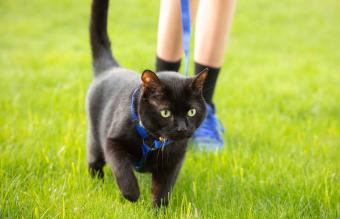
Cats are not normally thought of as pets you take out for a walk. While not every cat will enjoy this activity, there are many indoor cats that would love to take a stroll with you to explore the outdoors safely.
Can You Walk a Cat on Leash?
In short, the answer is yes, you can walk a cat on a leash, although whether you'll be successful will depend. "For some cats, walking on a leash is helpful and positive but for others, it's definitely not and can be traumatic for the cat and for you," says Associated Applied Animal Behaviorist Katenna Jones.
What Cats Make Good Leash-Walking Candidates?
Jones says that every cat is an individual and deciding whether a cat should be trained to walk on leash should be "taken on a case-by-case basis." She says cats that tend to enjoy walking on a leash are ones with personalities that fit these traits:
- Very confident
- Not easily startled
- Curious and inquisitive
The cat should also be physically healthy and up to date on all his or her vaccinations. The other key factor that Jones has found with successful leash-walking cats is that "they have a good, trusting relationship with their owners." She has also found that some cats with behavioral issues can benefit from walking on leash, such as cats that are frustrated and destructive in the house and some, but not all, cats with aggression issues toward other cats or people.
What Cats Should Not Be Leash Trained?
On the other hand, Jones advises owners to avoid leash training if their cat has any of these personality traits:
- Shy
- Startles easily to sudden movements or noises
- Sensitive or intolerant to being handled
- Physical limitations or health issues
She also recommends that owners with cats with behavioral issues be careful with attempting to leash train their cats to go for walks. While it can have a positive effect on some cats, she has also found it can make cats that are easily over stimulated become even more aggressive. If you have a concern at all about walking a cat with behavior problems, it's best to discuss with your veterinarian and a cat behavior professional first.
How to Train a Cat to Walk on a Leash
The best way to teach a cat to walk on a leash is by slowly acclimating them to the harness and leash to build up a positive association. If you move too quickly and the cat becomes stressed, this can make walking on a leash an unpleasant experience. While these steps seem extensive, following them can make walking on a leash a positive experience for both of you.

Acclimate the Cat to the Harness
- You will need some extra delicious treats that your cat really loves. Break them up into tiny bits.
- Take the harness and loosen it so that it will be loose on your cat, but not so loose that it will drag and trip the cat.
- Put the open harness area where the cat's head goes and hold it out in front of the cat with a treat in your hand in front of it (so that the cat's head is on the other side of the harness and the treats in your hand.
- Allow the cat to stick their head through the wide open harness to take the treat from your hand. Do not force the cat, it's important that his movements are voluntarily. If you want to use clicker training, click and treat when the cat places his head through the harness and then treat.
- Repeat this process several times until the cat is sticking his head through the hole without flinching or appearing nervous.
- If the cat is not placing his head through the harness, move back the difficulty by clicking and treating him for any movement of his head toward the harness, so that you are reinforcing successive approximations of movement closer and closer to your desired behavior of putting his head all the way in the harness hole area.
- Next you will be working on getting them used to the feeling of the harness on their bodies. Move the treat further away so that when the cat sticks his head through the harness, he will be pressing some of his body weight against it while reaching for the treat. Reward or click/treat for his body touching the harness.
- Repeat this step until the cat seems relaxed and does not appear nervous or annoyed by the harness touching his body.
- Now repeat step 7 and 8 but this time let the harness rest against them and let the cat walk around with the harness hanging loosely on them for a few steps. Reward with food or click/treat for remaining calm and moving forward with the harness on them.
- Note that if the cat is having problems with this step, you can drape a ribbon or a string on their bodies instead of the harness and get them used to this lighter weight against them. Then work up to increasing the weight until you match the weight of the harness.
- Now you can move on to their feet. Gently pick one foot up at a time and reward them with a food treat, or click/treat, for remaining calm. Repeat and put one foot at a time through the harness and reward or click/treat for allowing you to put their foot through the harness. You want to repeat this several times with just one foot and go "around their body" doing each foot a few times before moving on to the next.
- With the harness still loosely fitted, clip the harness. Have them walk around the house and reward or click/treat for every few steps they move when they're calm or happy and not showing any fear or annoyance with the harness on them.
- Now have them do some movements going up or down, such as jumping up on a cat tree or couch and then jumping down. You want them to get used to typical movements they might make while wearing the harness.
- If all is going well, slowly tighten the harness and repeat steps 12 to 13 until the cat is comfortable with the harness on and until you have it fully tightened.
- Excellent, you now have a cat comfortable with the harness!
Acclimate the Cat to the Leash
- Now it's time to get them used to feeling a leash on them. Attach a string or ribbon to the harness and let them drag it around for a bit until they seem comfortable.
- Gradually increase the weight of the "leash" by adding more string or ribbon to it. Work out to clipping the actual leash and letting the cat drag it. Remember to pair this with food rewards so they have a positive association with the activity.
- Now tie something to the leash with a bit of weight, such as a wash cloth or a stuffed toy, and let the cat drag that around.
- Being practicing "controlled breaking" which means gently holding the leash taut. Watch the cat's body language and reward them with a treat, or click/treat if you see them stopping, or stopping and moving back to you. Do not reward them for pulling against the leash when you hold it to put the "breaks on."

Taking Your Cat Leash Training Outside
This next step is critical in case your cat bolts when outside on a walk with you and you need to get him back to safety as soon as possible. Jones advises her clients to always take a cat outside on a walk in a carrier and to never walk the cat outside the door on a leash. "You don't want them to learn that it's ok to cross the threshold to go outside the door." It's much safer to teach them that going outside means getting in the carrier.
- You want to start this process first by getting your cat used to being put in and out of their cat carrier wearing the harness and leash.
- Practice picking them up and putting them in the carrier and then lifting them out and letting them walk about the house for a minute. Repeat the process a few times and reward them with treats each time.
- Do step number 2 in a low distraction area and then slowly build up to doing it in more distracting areas, such as an enclosed porch or your garage. Make sure your cat is in the carrier before you move to these areas.
Ready to Go Walking With Your Cat!
Now that you're ready to go walking, Jones recommends that you bring with you:
- Something with you that can get their attention in an emergency, such as a favorite toy or a very special treat
- A heavy towel or blanket to throw on the cat in case of an emergency to keep them from bolting, protect them, or pick them up with
- Your cat carrier
Take the cat outside in the carrier and take them out in the area you will be walking. Keep your initial walks very short and look for any possible behavioral problems with your cat. If all is going well, you can extend your walks further. Don't forget when you're done, the cat goes in the carrier before you bring them back inside the house.
Troubleshooting Leash Training Your Cat
You may observe your cat having problems with walking outside, which could be related to fear, frustration or an intense prey drive. Jones relates some common issues you may see during a walk with your cat.
Fearful Behavior
They may startle at a noise or something they see and start to bolt. If they do this, do not try to pull them toward you as they will instinctively resist this, and pulling against you can make it easier for them to get out of the harness. It's better to allow as much slack as you can in the leash and give the cat time to recover.
- Never yell as this can make the cat become more scared and fearful of you as well.
- Ideally, you should have the cat carrier nearby so your cat can run and hide in it if they're panicked.
- Otherwise, if the cat seems too scared and unable to relax, you can toss a heavy towel or blanket on them to protect and contain them.
- Do not grab the cat as a scared cat can act aggressively toward you. If you must pick the cat up, such as in a case where they are at risk of being attacked by a dog, toss a towel or blanket over them and grab them this way to protect your hands and arms.

Aggression Toward You
Sometimes a cat may act aggressively toward you during harness and leash training, and may react by biting at your hands. Or they may be fine during training, but act aggressively once you've taken them outside. Jones explains that this means the cat is overwhelmed and you've moved too fast. It's best to go back to square one and start the process over. You should be able to move faster through the process again since the cat is already used to the steps, but pay attention to their body language and make sure that you are moving with their level of comfort. Continued displays of aggression however indicate the cat is not a good candidate for leash walking.
Predatory Instincts
Some cats may seem fine during training, but once you take them outside, they become quickly distracted by movements. Especially when those movements are from birds and small furry critters! Jones relates that even items like leaves blowing in the wind can excite a cat with a high prey drive, so it's a good idea to rake any loose leaves before attempting a walk. If you can distract the cat with their favorite toy or treat, you can continue on the walk, or you can try walking them some place more urban and less rural to avoid encountering other creatures. However, if your cat is simply too fixated on prey wherever you go, they are probably not a good candidate for outside walks.
Training Is Taking Too Long
Some cat owners may feel like their cat is not making progress if they can't progress through the steps within a day or two. Jones says that in her experience, some cats can learn in a single session and other cats can take a week or more. If it's going to slow, remember that every cat is an individual.
Training Your Cat To Walk On a Leash Is Possible!
Walking your cat on leash can be a great way to give your cat physical and mental enrichment, as well as exercise for yourself. If you're thinking about trying to train your cat to walk on leash, make sure your cat has the right personality for this and is in good health, and take your time to train him at his own pace so he learns to love taking his strolls with you.







